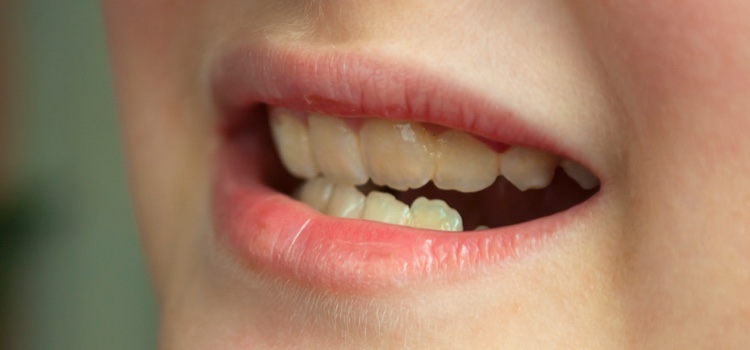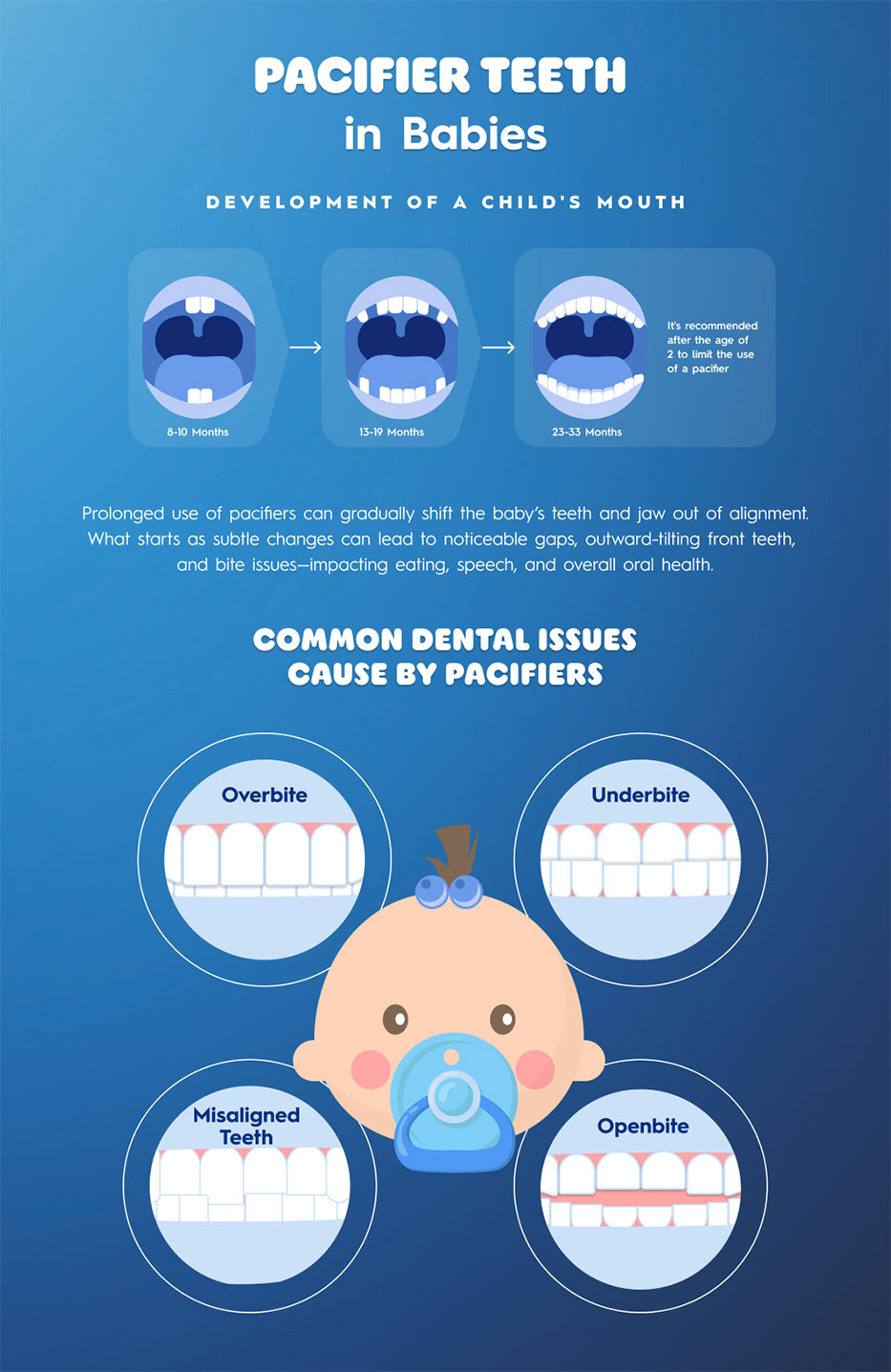Pacifier Teeth: Effects of Prolonged Use and Tips for Prevention

Summary
Key Takeaways
- Pacifiers can help calm and soothe a fussy baby.
- Prolonged pacifier use can lead to dependency, pacifier teeth, and middle ear infections.
Table of Contents

Approved and reviewed by Dr. Gans, a dental professional of over 10 years.
LEARN MORE >Key Takeaways
Pacifiers, while extremely valuable for soothing newborns, can lead to misalignment of teeth if used excessively. Learn more about what pacifier teeth are, their causes, and how to prevent them.
What Do Pacifiers Do?
A pacifier can be a blessing, especially for teething or cranky infants, as it satisfies their natural sucking reflex and soothes them. However, excessive reliance on a pacifier can lead to issues, including difficulty weaning off it and the development of "pacifier teeth," which can affect a child's oral development and tooth alignment.
Benefits of Pacifiers If you're relying on a pacifier to help calm or put your baby at ease, know you're not alone! Many parents rely on pacifiers for a whole host of reasons. According to the Mayo Clinic, pacifiers provide several benefits for babies and caregivers alike.
Pacifiers can be a great add-on for your routine as they:
- Help soothe: Some babies need to satisfy their sucking reflex more often than others, in these instances, a fussy baby can be calmed with a pacifier, especially between feedings.
- Improve sleep: Pacifiers can offer comfort to your little one as they drift off, helping them fall asleep faster.
- Reduce risk of SIDS: It is believed that sucking on a pacifier during bedtime or when napping can help reduce the risk of sudden infant death syndrome.
- Offer a Distraction: Early pediatric visits, while crucial for monitoring your child's development, often involve shots and blood tests. A pacifier can provide a welcome distraction from the associated discomfort.
- Alternative to thumb sucking: Some babies are fine with sucking on a blanket, others go right for their thumbs—some even into early childhood. Pacifiers are a great alternative solution to thumb sucking, since it is typically easier to wean toddlers off of pacifiers as opposed to thumbs. Thumb sucking can also lead to similar dental development issues.
Drawbacks of Excessive Pacifier Use:
As with all goods things, there are drawbacks to using a pacifier, especially if your child becomes too dependent on it:
- Pacifier teeth: Prolonged use of a pacifier can impact dental development, leading to misaligned teeth or the development of an overbite, crossbite, misalignment, or open bite.
- Routine disruptions: Excessive dependence on a pacifier can lead to frequent night wakings as your child searches for the pacifier that falls out of their mouth. These nightly disruptions can be challenging for both parents and the child.
- Speech delays: Extensive use of pacifiers can interfere with the development of speech and language.
- Overreliance: Children can form a comfort dependency on pacifiers, making it more difficult to phase pacifiers out of their daily routine.
Effects of Pacifiers on Teeth
"Pacifier teeth" refers to a type of dental misalignment caused by the prolonged use of a pacifier.
The most common dental problems that are caused by prolonged use of pacifiers are:
- Overbite: The jaw develops in such a way that the top front teeth protrude over the lower teeth.
- Crossbite: A form of tooth misalignment where the upper teeth obstruct or “fit” inside the lower teeth.
- Open Bite: Just as the name suggests, this condition occurs when the front teeth do not meet when the mouth is closed.
These oral health issues typically occur after the deciduous, or baby teeth, have already come in—when the child is between the ages of 2 and 4.
Pacifier Teeth Development

At What Age Does a Pacifier Affect Teeth?
Although more research into the relationship between pacifiers and teeth needs to be done, the American Academy of Pediatric Dentistry recommends limiting the use of pacifiers after 18 months of age. Stopping pacifier use at this age, or when the canine teeth develop, can help reduce the risk of crossbite
How to Prevent Pacifier Teeth
To help prevent pacifier teeth, try to wean your child off pacifiers around the age of 2 by:
- Gradually reducing pacifier use
- Using a pacifier only during naps or at bedtime
- Limiting continuous pacifier use during playtime. This can help encourage speech and language development
- Offering an alternative comfort method, such as a new toy
- Visit your dental professional regularly to monitor your child's teeth alignment
- Use a chart or stickers to encourage healthy habits as they gradually leave pacifiers in their past.
We get that saying goodbye to pacifiers may be tough, but with the right tips and some resilience, you and your little can get to a pacifier-free life:
- Dental checkups: Make sure to visit a pediatric dental professional twice a year after the age of 1 to better monitor their oral development, professional cleanings, and personalized recommendations.
Caring for Pacifier Teeth
Crooked, misaligned, or unevenly spaced teeth can be more difficult to brush, as more plaque and food debris can get trapped in tight, hard-to-reach spaces. Brush your child's teeth, or take a turn brushing after they try, until the age of six.
Follow these steps when brushing your child's teeth:
- Brush teeth along the gum line for 2 minutes, 2X/day. Kids 3+ should use a power toothbrush featuring extra-soft bristles. Why power? They're proven to get into all those nooks and crannies—cleaning more areas of the mouth that a regular manual toothbrush simply cannot. Extra-soft bristles gently clean tender gums, baby teeth, and wobbly teeth to help remove more plaque. Plus, the circular motion of the round brush head gets into all those hard-to-reach areas— adapting to their small smiles as it hugs each of their unique teeth.
- If using a manual toothbrush, gently glide the brush across their teeth with circular motions as you move from one tooth to the next.
- Brush back and forth across the front and back of each tooth—and don't forget those chewing surfaces!
How to Fix Pacifier Teeth
The good news? Pacifier teeth can be fixed as your child gets older! Orthodontic treatment such as braces can help straighten your child's smile, and with a good oral care routine in place at home, your kids' teeth can stay healthy and bright for a lifetime.
So, how do you know if your child needs orthodontic treatment? A dental professional will assess their jaw development and tooth alignment to determine if orthodontic treatment is needed.
Be sure to visit a dental professional by your child's first birthday for proper oral care tips and pacifier teeth prevention tactics.
Kid's Oral Care Recommendations
Complete Your Child's Oral Care Routine
- Brush your baby's tender gums and teeth with a soft-bristled toothbrush for baby ages 0-2 twice a day for two minutes each session
- Switch to an electric toothbrush once your child is 3 to remove more plaque for healthy teeth and gums such as the Oral-B Kids Electric Toothbrush for kids ages 3+ featuring Disney and Marvel characters.
- Encourage healthy habits with the Disney Magic Timer App which helps kids brush up to 2X longer.
- Visit their dental professional twice a year for professional cleanings and checkups.
Equip your kids' oral care routine with the toothbrush, toothpaste, and mouthwash that's right for them.
FAQs
-
Will pacifier teeth correct themselves?
-
Do pacifiers cause teeth problems?
-
At what age should you take pacifiers away?
Sources
- https://www.aapd.org/globalassets/media/ policies_guidelines/p_pacifiers.pdf
- https://www.healthline.com/health/pacifier-teeth
- https://www.mayoclinic.org/healthy-lifestyle/infant-and-toddler-health/in-depth/pacifiers/art-20048140
- https://pmc.ncbi.nlm.nih.gov/articles/ PMC2791560/
- https://www.pediatricdentalcenter.com/ blog/should-you-get-your-child-a-water-flosser/
- https://www.webmd.com/baby/pros-and-cons-of-using-a-pacifier
Table of Contents
- What Do Pacifiers Do?
- Effects of Pacifiers on Teeth
- Pacifier Teeth Development
- At What Age Does a Pacifier Affect Teeth?
- How to Prevent Pacifier Teeth
- Caring for Pacifier Teeth
- How to Fix Pacifier Teeth
- Kid's Oral Care Recommendations
-
- FAQs
- Sources

Approved and reviewed by Dr. Gans, a dental professional of over 10 years.
LEARN MORE >
Sign Up
for expert advice and exclusive offers

Sign Up
for expert advice and exclusive offers

